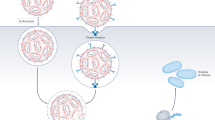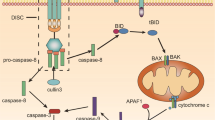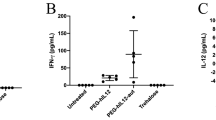Abstract
We have recently developed surface-shielded transferrin–polyethylenimine (Tf–PEI)/DNA delivery systems that target reporter gene expression to distant tumors after systemic application. In the present study, we used surface-shielded Tf–PEI/DNA complexes for delivering the gene for a highly potent cytokine, tumor necrosis factor-α (TNFα). TNFα is known for its ability to induce hemorrhagic tumor necrosis and tumor regression. However, the therapeutic application of TNFα is hampered by its high systemic toxicity dictating the need to target TNFα activity to the tumor. Systemic application of surface-shielded Tf–PEI complexes with the TNFα gene resulted in preferential expression of TNFα in the tumor without detectable TNFα serum levels, in contrast to the application of nontargeted complexes. Tumor-targeted TNFα gene delivery induced pronounced hemorrhagic tumor necrosis and inhibition of tumor growth in three murine tumor models of different tissue origins, Neuro2a neuroblastoma, MethA fibrosarcoma, and M-3 melanoma, with complete tumor regressions observed in the MethA model. No systemic TNF-related toxicity was observed due to the localization of the TNFα activity to the tumor. Targeted gene therapy may be an attractive strategy applicable to highly active, yet toxic, molecules such as TNFα.
This is a preview of subscription content, access via your institution
Access options
Subscribe to this journal
Receive 12 print issues and online access
$259.00 per year
only $21.58 per issue
Buy this article
- Purchase on Springer Link
- Instant access to full article PDF
Prices may be subject to local taxes which are calculated during checkout






Similar content being viewed by others
References
Behr JP . Gene transfer with synthetic cationic amphiphiles: prospects for gene therapy Bioconjug Chem 1994 5: 382–389 Review
Felgner JH, Kumar R, Sridhar CN et al. Enhanced gene delivery and mechanism studies with a novel series of cationic lipid formulations J Biol Chem 1994 269: 2550–2561
Wagner E, Zatloukal K, Cotton M et al. Coupling of adenovirus to transferrin–polylysine/DNA complexes greatly enhances receptor-mediated gene delivery and expression of transfected genes Proc Natl Acad Sci USA 1992 89: 6099–6103
Boussif O, Lezoulach F, Zanta MA et al. A versatile vector for gene and oligonucleotide transfer into cells in culture and in vivo — polyethylenimine Proc Natl Acad Sci USA 1995 92: 7297–7301
Kircheis R, Schüller S, Brunner S et al. Polycation-based DNA complexes for tumor-targeted gene delivery in vivo J Gene Med 1999 1: 111–120
Ogris M, Brunner S, Schüller S et al. PEGylated DNA/Transferrin–PEI complexes: reduced interaction with blood components, extended circulation in blood and potential for systemic gene delivery Gene Ther 1999 6: 595–605
Kircheis R, Wightman L, Schreiber A et al. Polyethylenimine/DNA complexes shielded by transferrin target gene expression to tumors after systemic application Gene Ther 2001 8: 28–40
Carswell EA, Old LJ, Kassel RL et al. An endotoxin-induced serum factor that causes necrosis of tumors Proc Natl Acad Sci USA 1975 72: 3666–3670
Old LJ . Tumor necrosis factor (TNF) Science 1985 230: 630–632
Watanabe N, Niitsu Y, Umeno H et al. Toxic effect of tumor necrosis factor on tumor vasculature in mice Cancer Res 1988 48: 2179–2183
Renard N, Lienard D, Lespagnard L et al. Early endothelium activation and polymorphonuclear cell invasion precede specific necrosis of human melanoma and sarcoma treated by intravascular high-dose tumour necrosis factor alpha (rTNF alpha) Int J Cancer 1994 57: 656–663
Van de Wiel PA, Bloksma N, Kuper CF et al. Macroscopic and microscopic early effects of tumor necrosis factor on murine MethA sarcoma, and relation to curative activity J Pathol 1989 157: 65–73
Shalaby MR, Aggarwal BB, Rinderknecht E et al. Activation of human polymorphonuclear neutrophil functions by interferon-γ and tumor necrosis factor J Immunol 1985 135: 2069–2073
Scheurich P, Thoma B, Ücer U et al. Immunoregulatory activity of recombinant human tumor necrosis factor (TNF)-alpha: induction of TNF receptors on human T cells and TNF-alpha mediated enhancement of T cell responses J Immunol 1987 138: 1786–1790
Bendtzen K . Interleukin-1, interleukin-6 and tumor necrosis factor in infection, inflammation and immunity Immunol Lett 1988 19: 183–192
Sugarman BJ, Aggarwal BB, Hass PE et al. Recombinant tumor necrosis factor-α: effect on proliferation of normal and transformed cells in vitro Science 1985 230: 943–945
Beutler B, Milsark IW, Cerami A . Passive immunization against cachectin/tumor necrosis factor protects mice from lethal effect of endotoxin Science 1985 229: 869–871
Beutler B, Cerami A . Cachectin and tumor necrosis factor as two sides of the same biological coin Nature 1986 320: 584–588
Anderson JA, Miller FN, Sims DE et al. Tumor necrosis factor causes microvascular protein leakage independently of neutrophils or mast cells J Surg Res 1994 56: 485–490
Kunstle G, Hentze H, Germann PG et al. Concanavalin A hepatotoxicity in mice: tumor necrosis factor–mediated organ failure independent of caspase-3–like protease activation Hepatology 1999 30: 1241–1251
Kircheis R, Milleck J, Korobko VG et al. Biological activity of mutants of human tumour necrosis factor-alpha Immunology 1992 76: 433–438
Van Zee KJ, Stackpole SA, Montegut WJ et al. A human tumor necrosis factor (TNF) alpha mutant that binds exclusively to the p55 TNF receptor produces toxicity in the baboon J Exp Med 1994 179: 1185–1191
Eggermont AM, Schraffordt Koops H, Klausner JM et al. Isolated limb perfusion with tumor necrosis factor and melphalan for limb salvage in 186 patients with locally advanced soft tissue extremity sarcomas. The cumulative multicenter European experience Ann Surg 1996 224: 756–764
Vrouenraets BC, Kroon BB, Ogilvie AC et al. Absence of severe systemic toxicity after leakage-controlled isolated limb perfusion with tumor necrosis factor-alpha and melphalan Ann Surg Oncol 1999 6: 405–412
Goula D, Benoist C, Mantero S et al. Polyethylenimine-based intravenous delivery of transgenes to mouse lung Gene Ther 1998 5: 1291–1295
Whitemore MA, Li S, Huang L . LPD lipopolyplex initiates a potent cytokine response and inhibits tumor growth Gene Ther 1999 6: 1867–1875
Kircheis R, Milleck J, Korobko VG et al. Differences in the biological activity of TNFα and TNFβ correlate with their different abilities for binding to the target cells Eur Cytokine Netw 1992 3: 381–390
Sherman ML, Spriggs DR, Arthur KA et al. Recombinant human tumor necrosis factor administered as a five-day continuous infusion in cancer patients: phase I toxicity and effects on lipid metabolism J Clin Oncol 1988 6: 344–350
Lenk H, Tanneberger S, Müller U et al. Phase II clinical trial of high-dose recombinant human tumor necrosis factor Cancer Chemother Pharmacol 1989 24: 391–392
Creaven PJ, Brenner DE, Cowens JW et al. A phase I clinical trial of recombinant human tumor necrosis factor given daily for five days Cancer Chemother Pharmacol 1989 23: 186–191
Mizuguchi H, Nakagawa T, Toyosawa S et al. Tumor Necrosis Factor α–mediated tumor regression by the in vivo transfer of genes into the artery that leads to tumors Cancer Res 1998 58: 5725–5730
Marr RA, Hitt M, Muller WJ et al. Tumour therapy in mice using adenovirus vectors expressing human TNFα Int J Oncol 1998 12: 509–515
Kircheis R, Wagner E . Polycation/DNA complexes for in vivo gene delivery Gene Ther Regul 2000 1: 95–114
Gerlowski LE, Jain RK . Microvascular permeability of normal and neoplastic tissue Microvasc Res 1986 31: 288–305
Hobbs SK, Monsky WL, Yuan F et al. Regulation of transport pathways in tumor vessels: role of tumor type and microenvironment Proc Natl Acad Sci USA 1998 95: 4607–4612
Papahadjopoulos D, Allen TM, Gabizon A et al. Sterically stabilized liposomes: improvements in pharmacokinetics and antitumor therapeutic efficacy Proc Natl Acad Sci USA 1991 88: 11460–11464
Wagner E, Curiel D, Cotten M . Delivery of drugs, proteins and genes into cells using transferrin as a ligand for receptor mediated endocytosis Adv Drug Dev Rev 1994 14: 113–135
Kircheis R, Kichler A, Wallner G et al. Coupling of cell-binding ligands to polyethylenimine for targeted gene delivery Gene Ther 1997 4: 409–418
Acknowledgements
We thank Alexandra Schreiber, Brenda Rohrhan, and Vanessa Rössler for excellent technical help, Gerhard Wallner for the TNFα bioassay, and Iduna Fichtner (Max-Delbrück Center) for kindly providing the MethA cells.
Author information
Authors and Affiliations
Corresponding author
Rights and permissions
About this article
Cite this article
Kircheis, R., Ostermann, E., Wolschek, M. et al. Tumor-targeted gene delivery of tumor necrosis factor-α induces tumor necrosis and tumor regression without systemic toxicity. Cancer Gene Ther 9, 673–680 (2002). https://doi.org/10.1038/sj.cgt.7700487
Received:
Published:
Issue Date:
DOI: https://doi.org/10.1038/sj.cgt.7700487
Keywords
This article is cited by
-
Distinct anti-proliferative effects of herbal melanin on human acute monocytic leukemia THP-1 cells and embryonic kidney HEK293 cells
BMC Complementary Medicine and Therapies (2020)
-
Trastuzumab-targeted gene delivery to Her2-overexpressing breast cancer cells
Cancer Gene Therapy (2016)
-
Systemic TNFα Gene Therapy Synergizes With Liposomal Doxorubicine in the Treatment of Metastatic Cancer
Molecular Therapy (2013)
-
Chimeric form of tumor necrosis factor-α has enhanced surface expression and antitumor activity
Cancer Gene Therapy (2009)
-
Plasmid CpG Depletion Improves Degree and Duration of Tumor Gene Expression After Intravenous Administration of Polyplexes
Pharmaceutical Research (2008)



